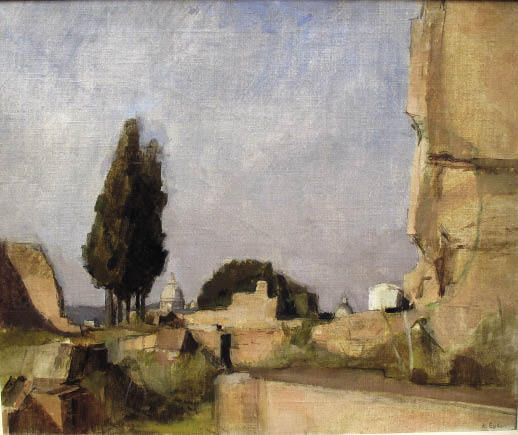A Critic’s Choice Selected by Andrew Lambirth
Browse & Darby, until 7 May
The bravest thing an art critic can do is to show their own work; the next bravest is to mount a show of the artists they admire. Publishing one’s critical opinions in print is one thing; hanging up the physical evidence in public is quite another. One normally fearless critic of my acquaintance, when invited to do it, declined with a shudder and a quote from ‘The Charge of the Light Brigade’.
Cork Street didn’t feel like the Valley of Death when I visited Andrew Lambirth’s Critic’s Choice last week. Lambirth has a long association with Browse & Darby, and his selection of 24 painters features half a dozen gallery artists, past and present, including Euan Uglow, Anthony Fry, Anthony Eyton, Patrick Symons and Jeffery Camp. So he’s not exactly in enemy territory, but neither is he entirely on safe ground. A guiding principle in selecting the show has been to give wall space to lesser-known artists without London dealers, and even the artists we know are not always as we know them, since Lambirth has chosen early work.
Jeffery Camp and Anthony Eyton are both represented by their younger selves, Camp in a luridly lit night painting, ‘Cream Pop’ (1960), featuring rock’n’rollers on Lowestoft’s South Pier, and Eyton in a sunny veduta of ‘St Peter’s from the Palatine’ (1951), painted while he was at the British School in Rome. Three youthful watercolours by Roland Collins, now 91, are of 1950s interiors on which he based his lithographic illustrations to Noel Carrington’s Colour and Pattern in the Home. Eileen Agar — one of the show’s ‘wild cards’, along with Ken Kiff and Roger Hilton — is represented by two mid-1980s paintings of surreally shaped rocks based on photographs taken at Ploumanach 50 years earlier. Completely contemporary in feel, they wouldn’t go amiss at the Frieze Art Fair.
So the tenor of the show is distinctly youthful, with octo- and nonagenarians’ younger personae rubbing shoulders with current young contemporaries Dan Llywelyn Hall (born 1980) and Raphael Pepper (born 1979). But space has also been made for mature artists with established national reputations, such as David Inshaw, who are rarely seen in London, and others with regional reputations below the capital’s radar. One such is Lancashire artist Helen Clapcott, who paints distant views of post-industrial Stockport in, of all unlikely media, tempera. Bathed in a pale golden Ravilious-like glow, her empty islands of former industrial activity circled by busy modern gyratory roads are deceptively mild-mannered commentaries on the marginalisation of our manufacturing past. ‘She is the conscience of Stockport as well as its poet,’ says Lambirth.
Another discovery for me were the portraits of Robert Dukes (born 1965), a former student of Uglow’s best known for his still-life paintings in the master’s manner. The three small heads on show here were transcribed as exercises for a portrait commission, two from portraits by Balthus of Thérèse Blanchard and one from a fleshy-faced Dutch burgher in ‘The Regents of St Elizabeth’s Hospital’ by Hals. The commission never came to anything, but these freely painted transcriptions have a life of their own, stepping out bravely from under Uglow’s shadow.
This is an educated selection, rich in visual references even in the work of its youngest artists: in the stooping figures in Dan Llywelyn Hall’s ‘Through the Thicket — After Van Gogh’ we recognise migrant potato pickers from the exhibition just closed at the RA. There’s also a trail of interesting little connections for the social historian of English 20th-century painting. The pair of reciprocal portraits by Anthony Eyton and Patrick Symons were painted in 1955 when the two young artists were sharing Anthony Fry’s house in Camberwell, in London; Eyton’s ‘St Peter’s from the Palatine’ is propped up behind him. We’re reminded how small the world of English painting is — and how unexplored, when it can yield up hidden treasures like Clapcott.






Comments